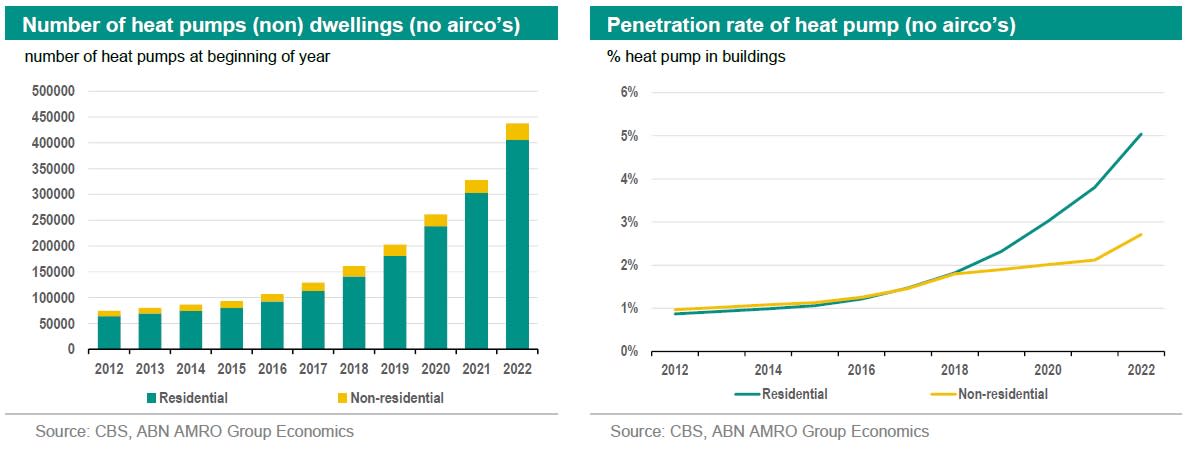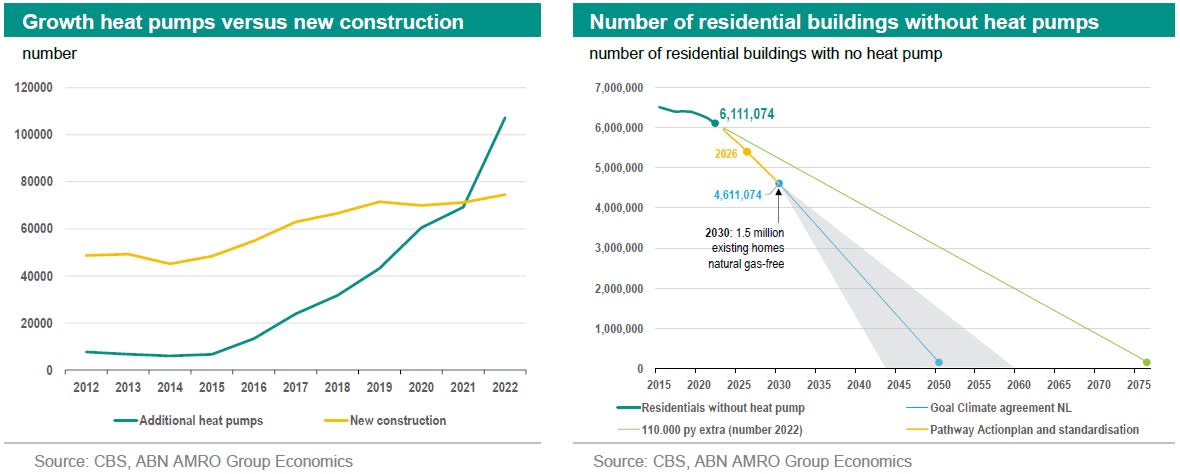Scaling up in production and installation of heat pumps inevitable

The number of heat pumps installed in the built environment has risen sharply. However, to achieve the set climate targets, further scaling-up is necessary during this year and next, while the higher installation pace would need to be maintained thereafter. Several policy measures should give scaling-up traction in the coming years. But currently there are still too many obstacles to overcome.
The number of heat pumps installed in the built environment has risen sharply
To achieve the set climate targets, further scaling-up is necessary in the short term
Several policy measures should give scaling-up traction in the coming years
But currently there are still too many obstacles to overcome
The built environment is a major consumer of gas. Some 40 per cent of total energy consumption goes to the built environment, with natural gas having a prominent share. The direct route of natural gas use in homes is for space heating and cooking, and indirectly, natural gas is used for electricity generation. However, the vast majority of gas consumption is for heating rooms. To make the transition to carbon-free built environment a reality, many homes need to be made gas-free in the coming years. In this respect, heat pumps are receiving increasing attention and a faster scale-up is therefore badly needed.
Trends in heat pumps
Many heat pumps rely on the use of electricity and also natural gas. These are the hybrid heat pumps commonly installed in homes. This variant therefore continues to require a gas connection. Air-to-water and air-to-air heat pump systems mainly use electricity, as the heat pump's compressor needs power. This also applies to geothermal and water-to-water heat pumps. However, both use less electricity than the air-to-water and air-to-air variants. The geothermal pumps are often ideal for new builds or large-scale renovations. In this analysis, we leave out air-to-air systems (similar to an air conditioner), as they are less effective as a main residential heating system and are not used for heating domestic hot water.
The number of installed heat pumps in the built environment (excluding air conditioners) in the Netherlands has risen sharply in recent years. For instance, over 340,000 heat pumps have been installed in homes in the last 10 years, a growth of 533%. In non-residential buildings, the number of heat pumps has grown slightly less rapidly. There, over 21,000 heat pumps (excl. air conditioners) have been installed since 2012, or a growth of 215%. In this case, non-residential buildings are buildings not used for living, greenhouses and stables. Non-residential buildings include accommodation that has a function other than residential, such as offices, hospitals, sports halls and schools. The growth in the number of heat pumps will continue in the coming years, fuelled partly by climate policy and currently also reinforced by geopolitical stress and the high gas prices.

The penetration rate of the heat pump - this is the extent to which the heat pump has penetrated the built environment - has also increased with the growth of installed heat pumps in recent years. Again, a difference can be seen between residential and non-residential properties. Over the past ten years, the share of heat pumps (without counting air conditioners) relative to the number of dwellings has increased by more than 4 percentage points, and for non-residential buildings it is almost 2 percentage points. However, as shown in the chart on the right above, the absolute percentage of heat pumps in buildings remains low.
Not just new construction
Of the more than 8 million homes in 2022 (baseline), more than 6.1 million homes do not yet have a heat pump acting as a main heating system. These homes have individual central heating boilers. The remaining almost 2 million homes currently have block heating, district heating or are electrically heated. According to the Dutch Climate Agreement, 1.5 million existing homes must be off natural gas by 2030. This is the ambition. To achieve this, one of the conditions is that from 2026 hybrid heat pumps will be the minimum standard for heating homes (and also non-residential buildings). This should partly become the catalyst for achieving the climate targets.
By making the hybrid heat pump mandatory for existing homes from 2026, the government hopes to accelerate the transition. From 2026, homeowners of existing homes must install a hybrid heat pump or another sustainable alternative as soon as the central heating system needs to be replaced. From 2023, every new-build house is required to be equipped with a heat pump. But the growth in demand for heat pumps is not only attributable to the sustainability measures in new construction. Existing homes are also increasingly fitted with a heat pump, with higher gas prices as a motivation for this.

According to the National Heat Pump Trend Report 2023 (published by Warmte365 and Dutch New Energy Research), the number of installed heat pumps in 2022 is around 110,000. This is roughly in line with CBS figures, which recorded 107,298 new heat pumps (non-air conditioning) in homes. If we hypothetically assume that 110,000 remains the annual number of heat pumps installed (light green line in the right graph), then at that rate, all existing homes will not be fitted with a heat pump until 2076. This clearly shows that further upscaling in the sector is necessary.
The central government's 'Action plan for hybrid heat pumps 2022 to 2024' - in which bodies such as Netbeheer Nederland, Techniek Nederland, Vereniging Warmtepompen and Natuur & Milieu were involved in the compilation of the plan - provides a glimpse into heat pump ambitions. The plan shows that a scale-up of the current number of hybrid heat pumps should take place with 125,000 additional hybrid heat pumps in the period 2022 to 2024. Then, if this pace is maintained after 2024, the ultimate goal does come within reach. However, it will all not be as straightforward as shown in the graph on the right. For instance, the desired capacity will not simply be reached within a few years. Also, some market players have already questioned some of the action points in the plan, especially about feasibility in the short time frame. Therefore, it is better to take into account a range for achieving the target (see shaded area). At the point when all obstacles are removed early, the action plan and the transition goes relatively smoothly, then the target might be reached earlier than 2050. However, the likelihood of this seems small, especially given the major challenges for which there is no good solution yet at present.
Obstacles in scaling up
Installing heat pumps can be a good step towards carbon neutrality of the built environment. What is important here is that heat pumps are powered by renewable energy sources. This means that investments in heat pumps and renewable energy sources should accelerate in the coming years. For now, however, it looks like it will take some time before a truly large scale is reached. The sector is already at its limits. Demand is currently so high that waiting times are rising sharply. Underlying this is the severe lack of installers and limited production capacity. And in addition, network capacity is still lacking in many regions to serve a larger scale of heat pumps.
An important condition before investing in a heat pump is to take insulation measures in homes. After all, only energy-efficient homes make the deployment of a heat pump profitable. However, practical experience will likely also show that far from every home can achieve the necessary level of insulation at all, making a heat pump not a smart option. For those homes where it is possible, the journey starts with encouraging those homeowners to make their homes more energy efficient. This requires the necessary financial incentives. But delays and waiting times are also increasing in this sector. On balance, however, heat pumps will only be part of the low-carbon puzzle for the built environment. Many more efficiency measures are needed for carbon-neutral homes and to further reduce gas demand. In any case, it is clear that in many of these obstacles - such as the shortage of installers, limited network capacity and financial barriers - the government has a pre-eminent role to play in smoothing this transition.
This article is part of the SustainaWeekly of 5 June 2023
